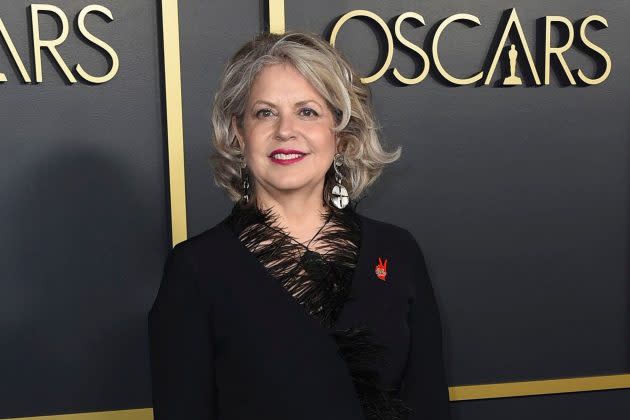‘Jojo Rabbit’ Costume Designer Mayes C. Rubeo On Managing Visual Arc Of Singular World War II Film

Click here to read the full article.
On Jojo Rabbit, costume designer Mayes C. Rubeo’s task was to go against the grain. Dodging the drab aesthetics expected of a World War II film, she instead pursued a visual palette that was as poetic as it was realistic.
Directed by Taika Waititi, the drama centers on Jojo (Roman Griffin Davis), an avid member of the Hitler Youth, who is furious when he discovers that his mother Rosie (Scarlett Johansson) is hiding a Jewish girl in the attic. Joined everywhere he goes by his imaginary friend Adolf (Waititi), Jojo strikes up a surprising friendship with the girl, which leads him to question his hateful worldview.
More from Deadline
First working with Waititi on Thor: Ragnarok, Rubeo responded immediately to the unique story the director was telling, beginning her work on Jojo by delving deep into period research. “We looked at many things—the world of Berlin in that era. We looked at the Führer from a very young age. I don’t like to call him the Führer; I mean, I don’t know what to call him,” the costume designer says. “Saying his name was always very strange.”
For Rubeo, the next step in the design process was to develop a visual arc for the film’s central characters. One of Jojo Rabbit’s best dressers, Rosie was kept “very vivid, very extroverted, artistic and eclectic” throughout the film. “We liked to believe that she was [part of] all these very artistic, creative movements from Paris, and therefore, she would know all the good artists from the time—like this artist that I love, Sonia Delaunay,” she explains. “That’s where I took my inspiration from for all the prints for Rosie, and the style and the geometrics, and the hats.”
In thinking through designs for Jojo, one of Rubeo’s key references was the character of Bruno, in the 1948 Italian Neorealist drama, Bicycle Thieves. “It was a very important point of guidance for me, of the tenderness of the child, and the innocence, and how we take advantage of them [as] adults, in terms of really making their mind our own,” the designer notes. “The fashion period was very similar, very close, [although] the Italian had different styles, and [Jojo] was a kid from the Jungvolk. So, I had to adapt this character to the fashion.”

For the artist, part of the challenge of Jojo Rabbit had to do with its point of view. Reflecting the world, as seen through the eyes of a 10-year-old, the film’s overall palette was inextricably linked to the arc of the character. Therefore, as Jojo evolved, the world around him would have to subtly transform, as well. “Because of all the circumstances that happen, he changes, and this changes the whole look of the movie, starting from the colors, and the mood of the temperature of the photography,” the costume designer reflects. “We had to do it very carefully, so people wouldn’t be hit over the head with these changes.”
While working on Jojo, Rubeo also had to overcome the surreal nature of the task before her, which involved dressing a version of Adolf Hitler, and manufacturing costumes for the Hitler Youth. Given the times we’re living through today, this part of the job was somewhat uncomfortable. But in the end, the costume designer could take comfort in the intention behind the film—one that Waititi has described as an ‘anti-hate satire.’
“Taika is a very respectful person. Somehow, if he feels weird saying the ‘H’ word, we all feel weird saying the ‘H’ word. And when they had to go from the room to the set, he wasn’t just going to walk around dressed like [Hitler]. He said, ‘Please give me something to conceal myself. I don’t feel comfortable walking around Barrandov Studios in this costume,’” Rubeo recalls. “So, yeah. It was weird. This is such a recent history and it’s horrific, [but] the purpose was to open people’s eyes.”
Earning her first Oscar nomination this year, for her work on Jojo Rabbit, Rubeo was recognized just last night with the Costume Designers Guild Award for Excellence in Period Film. For the designer, part of what made the project such a satisfying one to work on was her collaboration with Waititi—a visionary director who is always very involved with each of his departments. “He’s very communicative; he has no problem telling the way he sees things—and then he can even sketch things, if he doesn’t have time to explain himself,” Rubeo reflects. “It’s really a constant communication with Taika, in terms of how to create the costumes.”
Best of Deadline
Peacock Programming: List Of NBCUniversal Streaming Service’s Series, Films, Sports, News & More
Stan Lee's Legacy: Ranking The Hollywood Heroes Co-Created By The Marvel Comics Icon
Disney-Fox Deal: How It Ranks Among Biggest All-Time Media Mergers
Sign up for Deadline's Newsletter. For the latest news, follow us on Facebook, Twitter, and Instagram.

